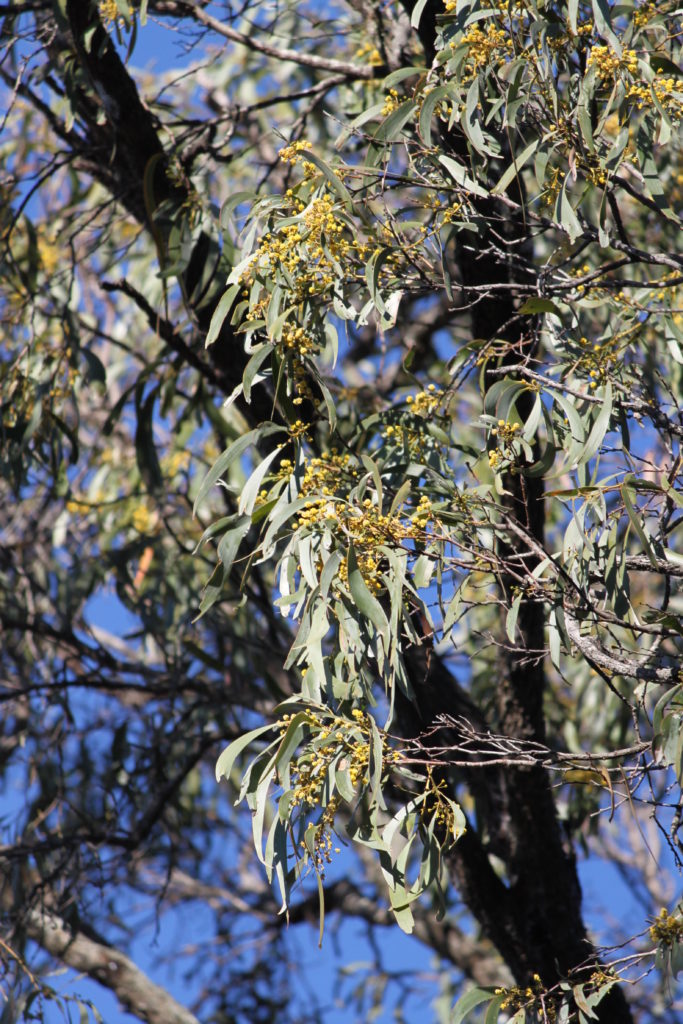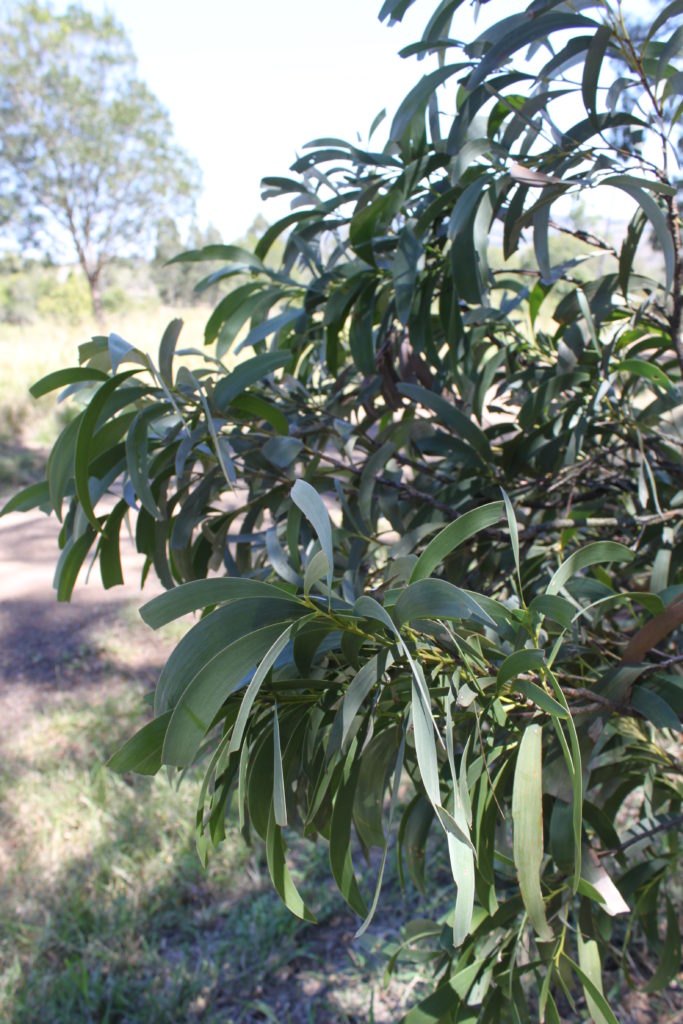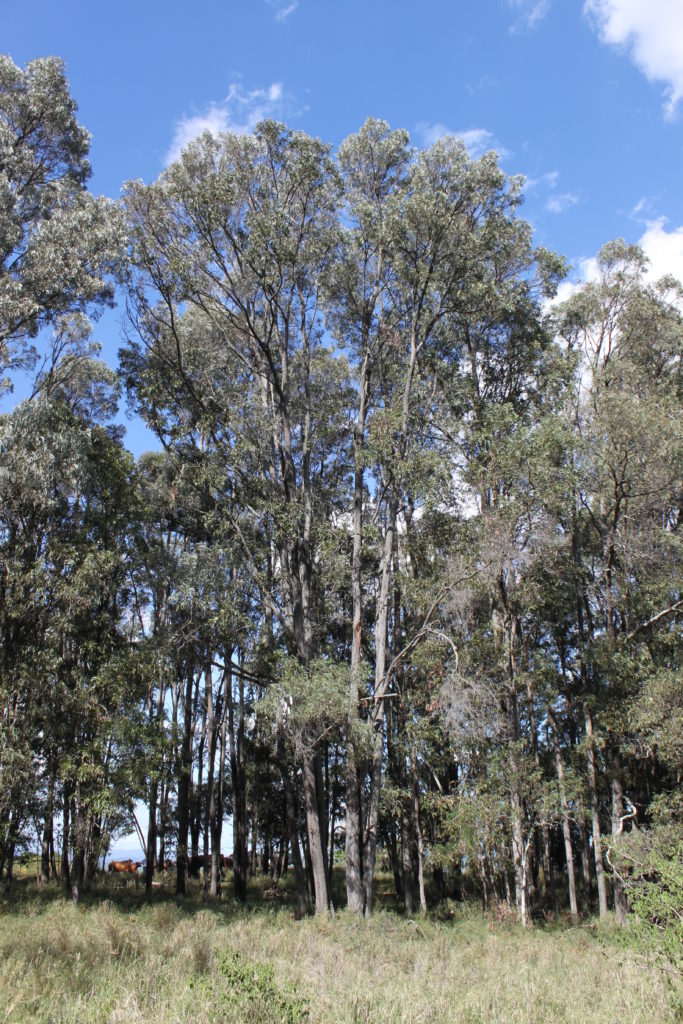The word “brigalow” may be a familiar term to many Australians, but how many would know that it refers to a wattle tree and can be found an hour’s drive from Brisbane’s CBD? This article aims to demystify this iconic tree and its associated ecosystem, the “Brigalow Scrub”.
Brigalow (Acacia harpophylla) is a slow growing, long-lived tree, which historically grew in dense stands across the drier parts of Central Queensland extending into South East Queensland (SEQ). Brigalow grows on relatively fertile soils and these areas were heavily cleared by early non-indigenous settlers. Patches of Brigalow Scrub can still be found today in the Lockyer, Scenic Rim, Ipswich and Somerset regions such as around Rosewood, Boonah and Gatton.
Brigalow often grows in association with, or adjacent to, dry rainforests or vine-thickets. A Brigalow canopy often hides a diversity of dry rainforest or vine-thicket plants. Brigalow, dry rainforests and vine-thickets are commonly referred to as “Softwood Scrubs”. Many Softwood Scrub plants have thick, tough leaves with spines, adapted to dry conditions.
Due to the extensive clearing, Brigalow Scrub is listed as an Endangered ecosystem under the Commonwealth Government’s Environment Protection and Biodiversity Conservation Act, acknowledging that less than 10% of the original extent of this ecosystem remains.
In SEQ, there are three main regional ecosystems (REs) that describe Brigalow:
- RE 12.8.23
- RE 12.9-10.16
- RE 12.3.10a
All of these ecosystems are listed as Endangered under Queensland’s Vegetation Management Act.
RE 12.8.23 describes Brigalow that grows on basalt geology with dark, cracking clay soils. Examples can be seen driving along Cochranes Road at Tallegalla, along Boonah-Fassifern Road near Boonah. The lower slopes of Mount French also show RE 12.8.23. Mapping done by Healthy Waterways and Catchments (formerly SEQ Catchments) shows that only 5% of the original extent of this ecosystem remains in SEQ, equating to about 416 hectares. RE 12.8.23 is not protected in any reserves, but 48 ha occurs on several Land for Wildlife properties around Marburg and Coolana.
RE 12.9-10.16 describes Brigalow that grows on sedimentary geology with brown, cracking clay soils. Examples of this RE can be seen driving along Glamorganvale Road between Glamorganvale and Lowood, and also around the township of Kalbar. Mapping shows that only 2% of the original extent of this ecosystem remains in SEQ, or about 757 hectares. Only 7 hectares of RE 12.9-10.16 are in reserves, but thankfully, 203 hectares of this ecosystem occurs on 50 Land for Wildlife properties, representing over 25% of the entire ecosystem!
RE 12.3.10a is the most cleared of all Brigalow ecosystems with only 50 hectares remaining in the Lockyer Valley and Scenic Rim areas. This ecosystem occurs on alluvial flats near creeks and rivers. Examples of RE 12.3.10a can be seen along the Warrego Hwy at Forest Hill, at the back of the Lowood Showgrounds and around Lower Mount Walker.
Given its slow growth and that individual trees can reach several hundred years of age, Brigalow timber is heavy and dense. It was a valued commodity and historically used for fenceposts, church pews, houses and sheds, as well as being manufactured into spears by indigenous people. Briglow and Rosewood (Acacia fasciculifera) are the oldest Acacias growing in SEQ.
Brigalow Scrub can be a difficult ecosystem to restore, but it is possible and examples can be found in SEQ. It all starts with finding local provenance seed. Why is local seed so important? The appearance of Brigalow differs widely across its range. West of the Great Dividing Range, the leaves of Brigalow are silver in colour, whereas here in SEQ, the leaves are generally dull-green or olive coloured. If ecological restoration is the aim, it is important to source Brigalow seeds from plants naturally occurring in SEQ to try to retain the genetics and the aesthetics of SEQ Brigalow.


Brigalow leaves are usually silver in colour (above left) in inland Queensland, or dull, olive green (above right) in South East Queensland. Similar to other wattles, Brigalow has yellow, puff-ball flowers that appear in late winter / early spring.
This first step is easier said than done. Brigalow is a lazy seeder, preferring to direct energy into its roots and suckering (sending up new shoots from the roots). So obtaining local provenance seed can be difficult as one plant may produce only a few seed pods once or twice a decade. Unlike seeds of other Acacias, Brigalow seeds lack a hard protective coat and will quickly germinate when dampened. Seeds that do fall to the ground remain viable for less than a year. Interestingly, it has been suggested that Brigalow may have developed its preference for suckering rather than setting seed in response to root and stem damage done by the now-extinct megafauna that roamed Australia tens of thousands of years ago.
Once obtained, Brigalow seeds germinate readily but will take about a year before they are ready to plant out. It is best to plant pioneering Softwood Scrub species around them so that the Brigalow have some shade and shelter to get started. For the first five years, Brigalow plants will grow very slowly until they get a decent root system established. Then they will head skywards.
Preferably, plant Brigalow in solid blocks close together (1.5m centres) rather than in rows. Specimens planted 16 years ago around Minden are now 5-10m tall. If a whole paddock was planted with Brigalow, after 20 years, it could look similar to a remnant Brigalow ecosystem. Brigalow trees reach their full height (about 30m) at about 50 years of age and some trees are known to be hundreds of years old.
Brigalow has been planted along several roads and highways in SEQ. An attractive stand of the silver-leaf form can be seen along the Warrego Highway near Marburg. It is uncertain why there are such distinct silver-leaf and dull green-leaf forms of Brigalow. One suggestion posed by the co-author, Martin Bennett, is that the silver-leaved form is favoured in hotter environments as the light colour may help reflect heat. In addition, the silver coating can sometimes be rubbed-off possibly implying that this textured silver layer may be able to hold water and dew better than a shiny, smooth green leaf.
Brigalow Scrub is often rich in plant diversity. On one Brigalow covered bluff near Rosewood, co-author Martin Bennett, recorded 190 plant species in just 4 hours. Unfortunately, most Brigalow patches now contain only about 80 plant species, as they have been heavily degraded by clearing, too much fire and overgrazing. Like subtropical rainforests, dry rainforests (e.g. Softwood Scrubs and Brigalow) are intolerant of fire and mature Brigalow trees and seeds in the soil will die from exposure to fire.
Over time, Brigalow Scrubs form a dense layer of understorey leaves, fallen timber and seasonal herbs and grasses. This understorey structure combined with dense shade provide perfect habitat for ground-dwelling animals such as the Black-breasted Button-quail, skinks and leaf-litter invertebrates such as ants and land snails. Brigalow Scrubs also attract rainforest birds such as Eastern Yellow Robins, as well as woodland bird species such as Grey-crowned Babblers.

Brigalow is a fascinating ecosystem, a mix of rainforest and dry woodland. We hope that this article inspires you to go for a trip out to the Lockyer, Scenic Rim, Ipswich or Somerset regions to see some Brigalow and learn more about it first-hand. We also hope that if you have Brigalow on your property that you are proud to be custodians of the few remaining patches that we have left in SEQ, and if you do see it flowering and setting seed, please let your Land for Wildlife Officer know.
For more information on Brigalow ecosystems, including plant lists for revegetation, download a copy of the relevant RE Factsheets from www. seqcatchments.com.au > resources > factsheets or ask your Land for Wildlife Officer for a copy.
References
Coaldrake JE (1971) Variation in some floral, seed, and growth characteristics of Acacia harpophylla (brigalow). Aust. J. Bot. 19, 335-52.
Johnson RW (1964) Ecology and control of Brigalow in Queensland. Queensland Department of Primary Industries.
Nix H (1994) The Brigalow. Chapter 10, pp. 198-233, In: Dovers S (Ed) Australian Environmental History: Essays and Cases. Oxford University Press.
Article by Martin Bennett
Acting Land for Wildlife Officer
Scenic Rim Regional Council
and
Deborah Metters
Land for Wildlife Regional Coordinator

There is Brigalow flowering outsidebof Gayndah again this year
I believe the planting of Acacia harpophylla at Marburg had its origins in seed collected east of Tara on the Western Downs.
Back in 2001 I was employed by a local nursery who supplied native tube stock chiefly for re-vegetation, and about November of that year i journeyed out to Tara on behalf of the nursery and collected said seed.
If my memory serves me correctly, there was talk at the time regarding a planting of Acacia harpophylla to be done at Marburg.
I moved on from the nursery at the end of that year, and in the latter part of 2019 for the first time since that collection, i journeyed out to the Western Downs to do some Eucalypt research.
Upon passing to the right of Marburg along the Warrego highway i noticed said trees growing on my left
and noticing there form being different from local provenance forms, I concluded they must be the form from east of Tara propagated and supplied by the nursery.
Hi Rory. Thanks for sharing. That is good to know. That patch of planted Brigalows along highway near Marburg certainly are not sourced from the Ipswich/Lockyer populations. It would make sense that they come from near Tara given their shiny silver leaves. Cheers
Very true Rory, GA, and the source was the Dalby Region.
Hi how do you collect the brigalow seeds
Hi Michael. Brigalow only flowers and sets seeds occasionally (about once a decade) and you need to take advantage of when this happens. The seeds do not have a hard seed case like other Acacias, so they need to be propagated straight away. Here’s a good article on this. http://toowoombaplants2008.blogspot.com/2015/07/brigalow.html